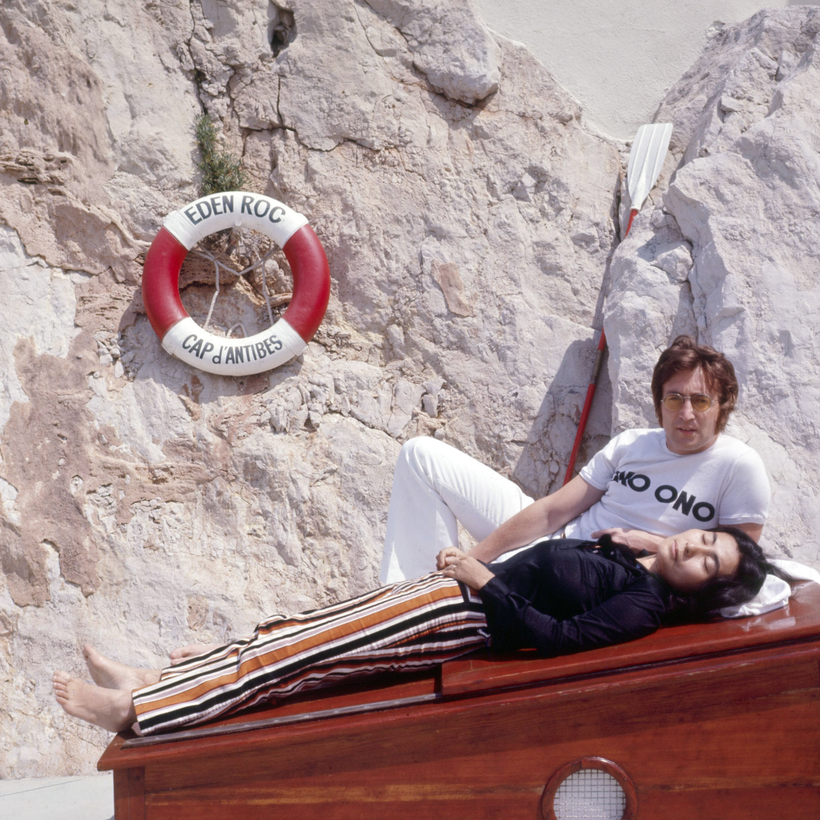The Beatles and Elvis Presley met one time. The Boys from Britain were on their second U.S. tour, in August 1965, when they stopped by the King’s Bel Air home for a meet and greet. The Beatles were somewhat let down by the awkward encounter, and Elvis a bit envious of the group that was making the girls scream the way he used to. “There’s four of them,” he lamented to a friend afterward. “But there’s only one of me.”
Yet, for many fans, there was only one indispensable Beatle. John Lennon was the Liverpool teen who founded the band, né the Quarry Men, and who brought Paul McCartney into the group even though he knew the younger kid was a better musician and might challenge his own supremacy. Lennon was the group’s guiding spirit, its defining wit, its most committed rebel—its “artist.” If Elvis’s death of a drug overdose in 1977 seemed sadly inevitable, Lennon’s murder three years later was a shock that still reverberates—the tragedy that not only ended any lingering fantasies of a Beatles reunion but put a final period on an era of rock history.

It’s been 40 years since Mark David Chapman’s fatal shots outside the Dakota apartment building in New York City, reason enough to justify a new biography. Written by British rock journalist Lesley-Ann Jones (the author of books on David Bowie and Freddie Mercury), The Search for John Lennon is impressionistic and personal, with zippy prose that strains a little too often for the rock-writer trope of mixing lyrics and life. (“He heard the news today, oh boy.”) But it is a probing, insightful, admirably evenhanded portrait of the artist as a young enigma.
Formidable Females
Jones frames her book loosely around the women in John’s life, the “formidable females” (almost all of them older) who “cherished or neglected, repaired or damaged, fortified or weakened him.” There were, first of all, his free-spirited mother, Julia, who (after his father had gone off to sea) turned her five-year-old son over to her sister Mimi to raise; Cynthia, the art-school girlfriend whom he got pregnant and married at age 21; and, of course, Yoko Ono, the savior/vixen who became his soulmate and musical partner for the last decade of his life.
But there are other, lesser-known women, too, such as Mona Best, the den mother whose cellar coffeehouse provided an early venue for the band and who served as their de facto first manager (her son Pete became their first drummer), and Alma Cogan, the British pop singer and alluring older woman with whom Lennon had an affair that ended with her death from ovarian cancer in 1966, leaving him near suicidal.

Loss defined Lennon’s early life. His beloved uncle George, a nurturing counterpoint to his strict aunt Mimi, died unexpectedly of an abdominal hemorrhage when John was 14. When he was 17, and just as he was re-establishing a relationship with her, his mother was struck and killed by a car while walking to the bus from Mimi’s house. And Stu Sutcliffe, John’s best friend from art school, who helped rename the band the Beatles (and played bass, badly, in the group for a short time), died of a brain aneurysm at 21.
With sources that range from former collaborators, rock critics, and kibitzing psychiatrists to Cynthia Lennon (who once asked Jones to collaborate on a memoir, which was later abandoned), Jones portrays a wounded artist who responded to these tragedies with a mix of insecurity and ego. “Overconfident, gauche, phlegmatic, paranoid, he could be both wildly extravagant and surprisingly restrained,” she writes. “He was spiteful but gentle. Mean, yet generous. Uncertain though discerning. Remorseless and self-reproachful in the same breath.”
For many fans, there was only one indispensable Beatle. John Lennon was the Liverpool teen who founded the band, the one who brought in Paul McCartney.
Lennon chafed under the concessions the Beatles had to make on the road to pop superstardom: the matching suits, the mop-top haircuts. “It was all about a ‘look’ and an ‘attitude’ that simply were not John,” said Cynthia. He was the first to grow weary of the touring madness, the whole frenzy of Beatlemania. Yet the miracle is that this prickly, iconoclastic artist managed to mesh so smoothly, for so long, in the greatest collaboration in rock history.

Then came Ono, who met Lennon at a gallery show in late 1966 and began pulling him away from the group well before its official breakup, in 1970. (From Sgt. Pepper on, it was more McCartney’s band than Lennon’s.) To some, Ono was a toxic influence, a “schemer and a control freak,” possessive and domineering from the get-go—they even went to the bathroom together. Their conceptual-art stunts were sometimes baffling; their marriage hardly an idyll. During a rocky patch in the mid-70s, Ono orchestrated an extramarital affair for him, with their pretty young assistant May Pang.
And yet Jones, on balance, is sympathetic. “She was the alpha female he needed, the partner he felt he deserved,” she writes. Before Ono, Lennon could be snarky and supercilious with people he felt insecure around. After he met Ono, “his cynicism began to melt away. He was at long last able to evolve. He would henceforth look to her for guidance and approval in most things, as a child looks to his mother.”
“Yoko saved him,” says Klaus Voormann, the musician and artist who befriended the Beatles in Hamburg. “They completed each other.” Their story was far from complete when it came to an abrupt end 40 years ago next week. Jones has revivified it with the passion and empathy it deserves.
Richard Zoglin is the author of Hope: Entertainer of the Century and Elvis in Vegas: How the King Reinvented the Las Vegas Show

